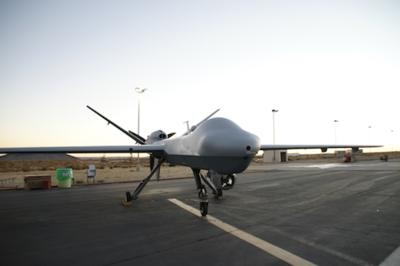Mon, Feb 23, 2015
System Designed To Provide Separation With Other Aircraft
General Atomics Aeronautical Systems, Inc. says it has successfully flight testing its Due Regard Radar, demonstrating the first fully functional air-to-air radar that meets due regard operation requirements.

Due regard operations for remotely piloted aircraft require that the aircraft is outfitted with airborne radar that can provide separation with other aircraft. This technology is key to integrating larger unmanned aircraft systems into the international airspace.
“This flight test is the culmination of over four years of radar development activity,” says Frank Pace, president of Aircraft Systems at GA-ASI. “DRR will allow users to operate Predator B independently in international airspace without the need for land-based, sea-based or off-board airborne airspace surveillance, offering our customers greater freedom of movement around the globe.”
The test was designed to confirm the radar’s onboard functionality and integration with the traffic alert and collision avoidance system II that is used on most commercial aircraft. Collision avoidance maneuvers were automatically and successfully executed to evade planned encounters with small and medium sized manned aircraft. The radar was able to simultaneously track multiple targets while continuing to search a wide field-of-regard, according to a company press release.
“We are honored to be leading the effort to help define standards for flying aircraft such as Predator B in the national airspace system in close cooperation with the FAA, NASA, and our industry partners,” says Executive Vice President of Mission Systems for GA-ASI Claudio Pereida.
Multiple flight tests took place throughout December at Gray Butte Flight Operations Facility and Edwards Air Force Base in Palmdale, California. The DRR is now ready for a customer to conduct an operational test and evaluation in an operational environment.
The integrated sense-and-avoid system including the DRR and TCAS II will continue to fly aboard NASA’s Ikhana unmanned aircraft in 2015 to measure the performance of the entire system in a variety of scenarios.
(Image provided by General Atomics)
More News
Aero Linx: Model Aeronautical Association of Australia MAAA clubs are about fun flying, camaraderie and community. For over 75 years, the MAAA has been Australia’s largest fl>[...]
Touchdown Zone Lighting Two rows of transverse light bars located symmetrically about the runway centerline normally at 100 foot intervals. The basic system extends 3,000 feet alon>[...]
“Discovery and innovation are central to our mission at Virgin Galactic. We’re excited to build on our successful record of facilitating scientific experiments in subor>[...]
How To Get A Story On Aero-TV News/Feature Programming How do I submit a story idea or lead to Aero-TV? If you would like to submit a story idea or lead, please contact Jim Campbel>[...]
Student Pilot Reported That During Rotation, “All Of A Sudden The Back Of The Plane Kicked To The Right..." Analysis: The student pilot reported that during rotation, “>[...]
 ANN's Daily Aero-Linx (05.02.24)
ANN's Daily Aero-Linx (05.02.24) ANN's Daily Aero-Term (05.02.24): Touchdown Zone Lighting
ANN's Daily Aero-Term (05.02.24): Touchdown Zone Lighting Aero-News: Quote of the Day (05.02.24)
Aero-News: Quote of the Day (05.02.24) ANN FAQ: Contributing To Aero-TV
ANN FAQ: Contributing To Aero-TV NTSB Final Report: Cirrus Design Corp SR20
NTSB Final Report: Cirrus Design Corp SR20



